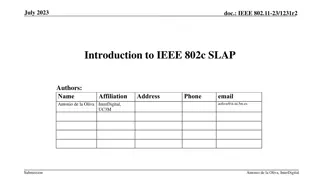
Common Challenges in Flatbed Dispatching and How to Address Them
Discover practical tips to overcome common challenges in flatbed dispatching and improve efficiency in your freight operations
Download Presentation

Please find below an Image/Link to download the presentation.
The content on the website is provided AS IS for your information and personal use only. It may not be sold, licensed, or shared on other websites without obtaining consent from the author. Download presentation by click this link. If you encounter any issues during the download, it is possible that the publisher has removed the file from their server.
E N D
Presentation Transcript
Common Challenges in Flatbed Dispatching and How to Address Them The transportation industry's intricate landscape presents unique challenges for flatbed dispatching operations. From weather-related complications to regulatory compliance, dispatchers must navigate various obstacles while ensuring efficient and safe cargo delivery. Understanding these challenges and implementing effective solutions is crucial for success in the flatbed dispatch services sector. The Unpredictable Variable of Weather Managing weather-related challenges stands as one of the most significant hurdles in dispatch flatbed operations. Heavy rainfall can compromise cargo integrity, while strong winds pose risks to load stability, especially when transporting oversized or irregularly shaped items. Successful flatbed operations require implementing comprehensive weather monitoring systems and maintaining open communication channels between dispatchers and drivers.
Strategic Weather Management Experienced dispatchers understand the importance of proactive weather planning. This involves creating flexible routing alternatives and establishing clear protocols for various weather scenarios. Regular weather updates and route modifications help prevent cargo damage and ensure timely deliveries while maintaining safety standards. Load Security: A Critical Priority The Art of Load Securement Proper load securing represents a fundamental aspect of flatbed transportation success. Each cargo type presents unique securing requirements, demanding specialized knowledge and equipment. Key Securement Considerations: 1. Load weight distribution and balance 2. Appropriate strap and chain placement 3. Regular security checks during transit 4. Compliance with DOT regulations The complexity of load securement extends beyond basic strapping techniques. Professional dispatchers must ensure drivers understand the specific requirements for different cargo types, from steel coils to construction equipment. Capacity and Route Optimization Managing fleet capacity while optimizing routes requires a delicate balance of strategic planning and real-time adaptation. Successful dispatch operations depend on maximizing asset utilization while minimizing empty miles.
Load Planning Matrix Priority Consideration Impact High Distance Fuel efficiency and driver hours Medium Load type Equipment requirements High Deadhead Profitability Critical Delivery windows Customer satisfaction Technology Integration in Modern Dispatching The evolution of dispatching technology has revolutionized how flatbed operations manage their fleets. Modern dispatch software provides real-time visibility, automated routing, and enhanced communication capabilities. These technological solutions help address multiple challenges simultaneously while improving operational efficiency. Advanced Dispatch Solutions Professional dispatching services now leverage sophisticated software platforms that offer: 1. Real-time GPS tracking and route optimization 2. Automated load matching and capacity management 3. Digital documentation and compliance monitoring 4. Instant communication between all stakeholders Driver Management and Retention The success of flatbed operations heavily depends on skilled drivers who understand the complexities of handling specialized cargo. Creating a supportive environment that
promotes driver satisfaction and professional growth proves essential for long-term success. Building Strong Driver Relationships Establishing effective communication channels between dispatchers and drivers helps create a collaborative working environment. Regular check-ins, performance recognition, and addressing concerns promptly contribute to higher driver retention rates. Professional dispatch services understand that experienced drivers represent valuable assets and invest in maintaining positive relationships through fair load distribution and respect for driver preferences. Regulatory Compliance and Documentation Navigating the complex regulatory landscape requires constant attention to detail and thorough documentation. Successful flatbed operations maintain comprehensive compliance programs that address: Essential Compliance Elements 1. Hours of Service (HOS) monitoring 2. Weight restrictions and permits 3. Equipment inspections and maintenance records 4. Driver qualification files 5. Insurance requirements Professional dispatch services must stay current with changing regulations while ensuring all documentation remains accurate and accessible. Communication Excellence Effective communication serves as the foundation for successful flatbed operations. Dispatchers must maintain clear lines of communication with multiple stakeholders, including: 1. Drivers and fleet managers
2. Customers and shipping facilities 3. Regulatory authorities 4. Maintenance providers Enhanced Communication Strategies Professional dispatch services implement multi-channel communication systems that enable quick response times and clear information sharing. This includes utilizing mobile apps, digital logging systems, and centralized communication platforms. Equipment Management and Maintenance Proper equipment management directly impacts operational efficiency and safety. Professional flatbed dispatch services maintain detailed records of: Equipment Tracking Components 1. Regular maintenance schedules 2. Repair Histories 3. Equipment certifications 4. Replacement schedules 5. Safety inspection results Customer Service Excellence Outstanding customer service differentiates successful dispatch operations from their competitors. This involves: 1. Proactive communication about delivery status 2. Quick response to customer inquiries 3. Flexible solutions for changing requirements 4. Professional problem-solving approaches
5. Consistent service quality Industry Partnerships Developing strong relationships with industry partners helps address various operational challenges. Professional dispatch services maintain networks of: 1. Reliable carriers 2. Equipment suppliers 3. Maintenance providers 4. Insurance partners 5. Regulatory consultants Conclusion Success in flatbed dispatching requires a comprehensive approach to addressing multiple challenges simultaneously. By implementing strategic solutions and maintaining high operational standards, dispatchers can ensure efficient, safe, and profitable transportation services. The key lies in combining experience, technology, and professional expertise to overcome the unique challenges of flatbed transportation. Tech Rig Dispatch stands as a leading provider of professional flatbed dispatch services, combining industry expertise with cutting-edge technology. With our proven track record of success, we deliver reliable, efficient, and safety-focused dispatching solutions for flatbed carriers across North America. Site Article: Common Challenges in Flatbed Dispatching and How to Address Them






















